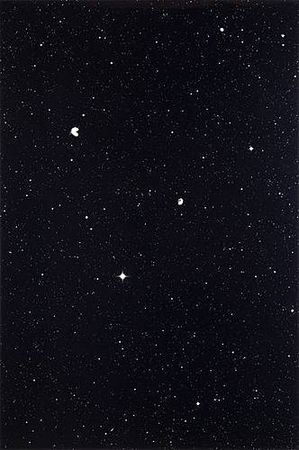"Infinitum" @ the Palazzo Fortuny in Venice
Gonzales Coques (1614-1684), “An unfinished portrait of a man posting a letter, in an interior”, 1640, 56 x 44 cm, Oil on canvas, Private Collection, Belgium
VENICE.- The Fondazione Musei Civici di Venezia and the Vervoordt Foundation announce Infinitum, taking place in the Palazzo Fortuny in Venice from 6 June until 15 November, 2009. With In-finitum, the trilogy which started with Artempo: Where Time Becomes Art (Venice, 2007) and continued with Academia: Qui es-tu? (Paris, 2008) will come full circle. Once again set in the magnificent surroundings of the Palazzo Fortuny, In-finitum will guide the visitor from the soul of the unfinished to the border of the infinite, a spiritual journey along works of art abundant with energy.
The trilogy as conceived by Axel Vervoordt establishes a perfect balance through the natural time-flow between its three chapters. Artempo: Where Time Becomes Art dealt with the beauty of passing time touching the world, with the mysteriousness of patina and the magical osmosis which exists where cosmos and matière interact. In Academia: Qui es-tu?, the transmission of knowledge and wisdom held center stage, a fixed focal point gently rocked however by the continuous perpetuum mobile of questions and answers. The finale, In-finitum, will traverse into the other realm as it reaches into the universe of the unfinished and the infinite.
Questioning ‘infinity’ is a spiritual journey. The human condition strives for perfection, hungers to be in pursuit of completion. On this quest for the imperceptible, the unimaginable, the incomprehensible, man gets confronted with his boundaries and struggles with what is unachievable. It is in this part of incompleteness that the infinite resides, the void, the recipient and source of the all and everything, of the none and nothing. The infinite as a never-ending road to completion, knowledge and enlightenment has inspired intellectuals, artists, scientists and literati since the beginning of reasoning times. Their discoveries and writings, artistic impressions and thoughts will shape another segment of the In-finitum exhibition.
In-finitum will present works by Giovanni Anselmo; Pierre Bonnard; Berlinde de Bruyckere; Donato Creti; Michael Borremans; Eugène Delacroix; Ray & Charles Eames; Lucio Fontana; Adam Fuss; Victor Hugo; Ann-Veronica Janssens; Anish Kapoor; Anselm Kiefer; Kimsooja; Yves Klein; Piero Manzoni; Fausto Melotti; Mario Merz; Joan Mirò; Tatsuo Miyajima; Renato Nicolodi; Roman Opalka; Pablo Picasso; Otto Piene; Giovanni Battista Piranesi; Michelangelo Pistoletto; Gerhard Richter; Thomas Ruff; Kazuo Shiraga; Ettore Spaletti; Diana Thater; Jef Verheyen; Rik Wouters and many others.
In-finitum is given shape by a curatorial team existing of Axel Vervoordt, Daniela Ferretti, Giandomenico Romanelli and Francesco Poli. Many friends and fellow thinkers have contributed thoughts and suggestions along the way.
The trilogy will also be completed in a musical sense as In-finitum will be accompanied by a third composition created by Mireille Capelle, entitled Sunyata. Ms Capelle wrote Annello di se for Artempo: Where Time Becomes Art and Naga for Academia: Qui es-tu?.
Marlène Dumas (°1953), “Skaam”, 40 x 49,5 cm, Courtesy of Zeno X, Antwerp
Après « Artempo » en 2007 et « Academia. Qui es-tu ? » en 2008, Axel Vervoordt profite à nouveau de la Biennale de Venise pour clore sa trilogie. « In-finitum » prendra ainsi ses quartiers au Palazzo Fortuny à partir du 6 juin. Avec « Artempo », Axel Vervoordt développait le thème du temps qui passe. Dans « Academia. Qui es-tu ? », il s’interrogeait sur la transmission de la connaissance en prenant comme source le « gnoti seoton », le célèbre connais-toi toi-même de Platon. Pour « In-Finitum », l’antiquaire belge s’attaque aux notions d’infinis et de voyages spirituels. Pour ce faire, il a convoqué des artistes très variés : Delacroix et Thomas Ruff, Pierre Bonnard et Anish Kapoor, Alexander Calder et Roman Opalka, Picasso et Ann-Veronica Janssens… Au-delà des arts plastiques, l’exposition sera aussi musicale. Mireille Capelle, qui avait déjà œuvré dans les deux opus précédents, a créé spécialement une composition intitulée XXX. Henry-Claude Cousseau, le directeur de l’Ensba, qui a accueilli « Academia. Qui es-tu ? », résume ainsi le projet du collectionneur et marchand belge : « Le grand triptyque qu’Axel Vervoordt a entrepris de concevoir au sujet de l’art […] répond canoniquement aux trois âges, aux trois visages d’une œuvre d’art. Le temps dans lequel elle vient s’inscrire, la transmission qui lui assure la pérennité et le dépassement qui lui permet de délivrer son sens à l’infini ».

/https%3A%2F%2Fprofilepics.canalblog.com%2Fprofilepics%2F1%2F0%2F100183.jpg)





/http%3A%2F%2Fstorage.canalblog.com%2F39%2F30%2F119589%2F62025513_p.jpg)
/http%3A%2F%2Fstorage.canalblog.com%2F47%2F33%2F119589%2F46300897_p.jpg)
/http%3A%2F%2Fstorage.canalblog.com%2F46%2F29%2F577050%2F43545407_o.jpg)
/http%3A%2F%2Fstorage.canalblog.com%2F60%2F37%2F577050%2F36504892_o.jpg)